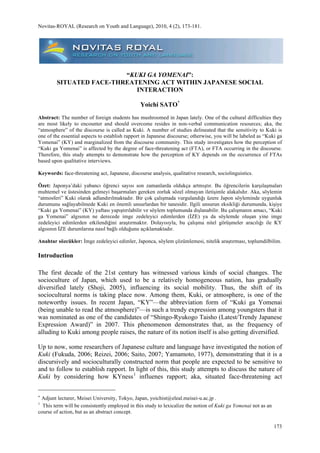This document summarizes a research study on "Kuki ga Yomenai" (KY), which refers to being unable to read the atmosphere or social cues in Japanese interaction. The study investigates how the perception of someone as KY is influenced by face-threatening acts (FTAs) during a conversation. The author conducted interviews with university students who had experience in a volunteer group. The interviews were analyzed as case studies to understand situations where KYness led to conflict in establishing rapport. The goal of the research was to provide insights into Kuki, its role in Japanese social interaction, and implications for non-Japanese people.







![Yoichi Sato
180
by the degree of FTAs occurring in the discourse. In addition to that, the notion of Kuki is so
multidimensional and it relates to various kinds of aspects to realize harmonious interaction.
In summary, Mei’s ethnographic study represents that the Kuki construction is highly
dependent upon the discursively dominant figures. Likewise, Maiko’s story suggested that
Japanese community construction, or both vertically and horizontally stratified hierarchy,
highly influences the perception of KY. Furthermore, Goro’s study discovered that the
perception of KYness is affected by FTAs occurring in any parts of their in-group discourse,
not only mutual FTA between inteactants. Lastly, Nobita and Shun’s struggle clearly
represents the multidimensionality of Kuki. Nobita attempted to use a “positive politeness
strategy” vis-à-vis Shun refused it by using a “negative politeness strategy”.
Since Kuki is a nation-widely recognized notion, the study of it should be expanded to include
much larger scale population. Besides, Nobita and Shun’s case study indicated that it is also
important to employ multiple perspectives to fully analyze the nature of Kuki; i.e. it is not
fully discussed only by means of one particular person’s perspective. Therefore, triangulation
of the perspectives is vital to increase the validity of the analysis. In doing so, the research
methods should also be revisited.
*This paper was developed out of a conference paper that the author presented at Taigu
Komyunikeshon Gakkai held at Waseda University in Tokyo, Japan, on April 18th, 2009.
References
Brown, P., & Levinson, S. (1987). Politeness: Some universals in language usage.
Cambridge: Cambridge University Press.
Culpeper, J. (1996). Towards an anatomy of impoliteness. Journal of Pragmatics, 25,
349–367.
Culpeper, J., Bousfield, D., & Wichmann, A. (2003). Impoliteness revisited: With special
reference to dynamic and prosodic aspects. Journal of Pragmatics, 35, 1545-1579.
Davis, K.A. (1995). Qualitative theory and methods in applied linguistics research. TESOL
Quarterly, 29(3), 427-453.
Doi, T. (1971). “Amae” no kozo [Anatomy of interdependence]. Tokyo: Kobundo.
Fukuda, T. (2006). “Ba no kuki” ga yomeru hito, yomenai hito [The distinction between Kuki
readers and non-Kuki readers.]. Tokyo: PHP Shinsho.
Goffman, E. (1967). Interaction rituals: Essays on face-to-face behavior. London: The
Penguin Press.
Grice, H.P. (1989). Studies in the ways of words. Cambridge, MA.: Harvard University Press.
Hamaguchi, E., Kumon, S., & Mildred, R.C. (1985). A contextual model of the Japanese:
toward a methodological innovation in Japan studies. Journal of Japanese studies, 11(2),
289-321.](https://image.slidesharecdn.com/sato-150624234644-lva1-app6892/85/Sato-8-320.jpg)
![Novitas-ROYAL (Research on Youth and Language), 2010, 4 (2), 173-181.
181
Kitazawa,T., Katagiri, R., Akiba, Y.,Seiya, Y., & Mayama, H. (2008). Shitsuteki chosagiho to
shitsuteki deeta no tokushitsu [The feature of qualitative research approach and its data]. In T.
Kitazawa & M. Koga (Eds.), Shitsutekichosaho wo manabuhito no tameni (pp. 37-59). Kyoto:
Sekaishisosha.
Nakane, C. (1967). Tate shakai no ningen kankei [Japanese society]. Tokyo: Kodansha.
Reizei, A. (2006). “Kankei no kuki” “Ba no kuki” [“Relational Kuki” ”Situational Kuki”].
Tokyo: Kodansha Gendai Shinsho.
Saito, T. (2007). Ki no chikara-Ba no kuki wo yomu, nagare wo kaeru [The power of
atmosphere-Read the atmosphere, negotiate the discourse]. Tokyo: Bungeishunju.
Shoji, H. (2005). Nihon no Tagengoka [Multilingualization of Japan]. In N. Masada & H.
Shoji (Eds.), Nihongo tagango shakai (pp. 48-56). Tokyo: Iwanami shoten.
Spencer-Oatey, H. (2000). Culturally speaking: Culture, communication and politeness.
London: Continuum.
Spencer-Oatey, H. (2005) (Im)Politeness, face and perceptions of rapport: Unpackaging their
bases and interrelationships. Journal of Politeness Research, 1(1), 113–137.
Sugiyama, L.T. (1974). Japanese patterns of behavior. Honolulu, HI: University of Hawaii
Press.
Takiura, M. (2008). Poraitonesu nyumon [A first step to politeness theory]. Tokyo:
Kenkyusha.
Tanaka, H. & Zhang, X. (2008, July). Construction of face in Japanese business settings. A
paper presented at 4th
international symposium on politeness, Budapest, Hungary.
Wenger, E. (1998). Communities of practice: Learning, meaning, and identity. Cambridge:
Cambridge University Press.
Yamamoto, S. (1977). “Kuki” no kenkyu [Study of “Kuki”]. Tokyo: Bungei Shunju.](https://image.slidesharecdn.com/sato-150624234644-lva1-app6892/85/Sato-9-320.jpg)